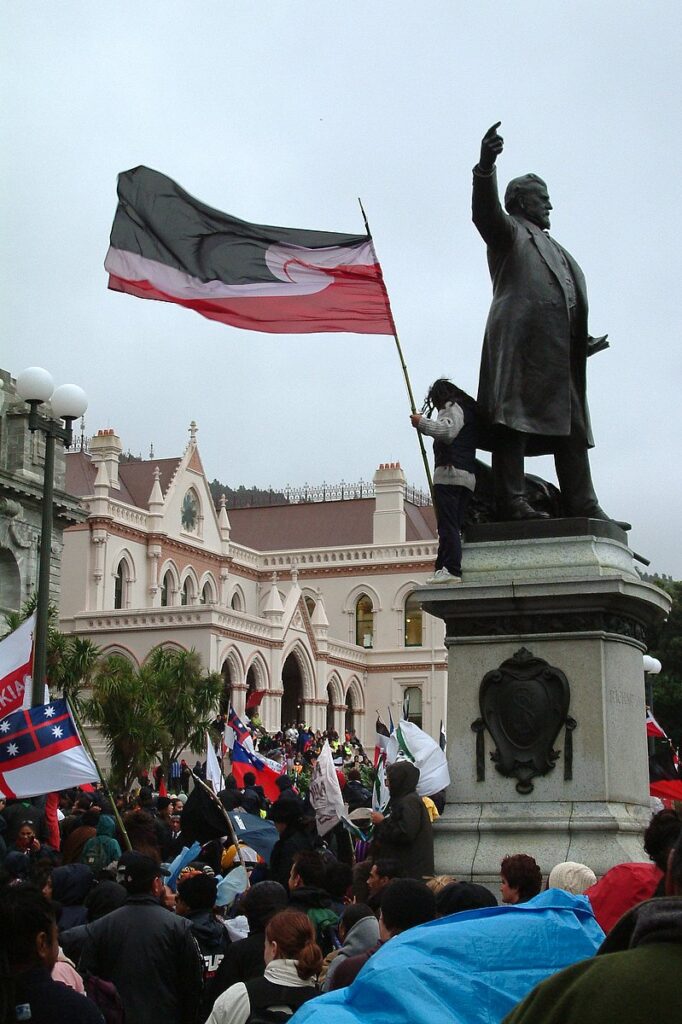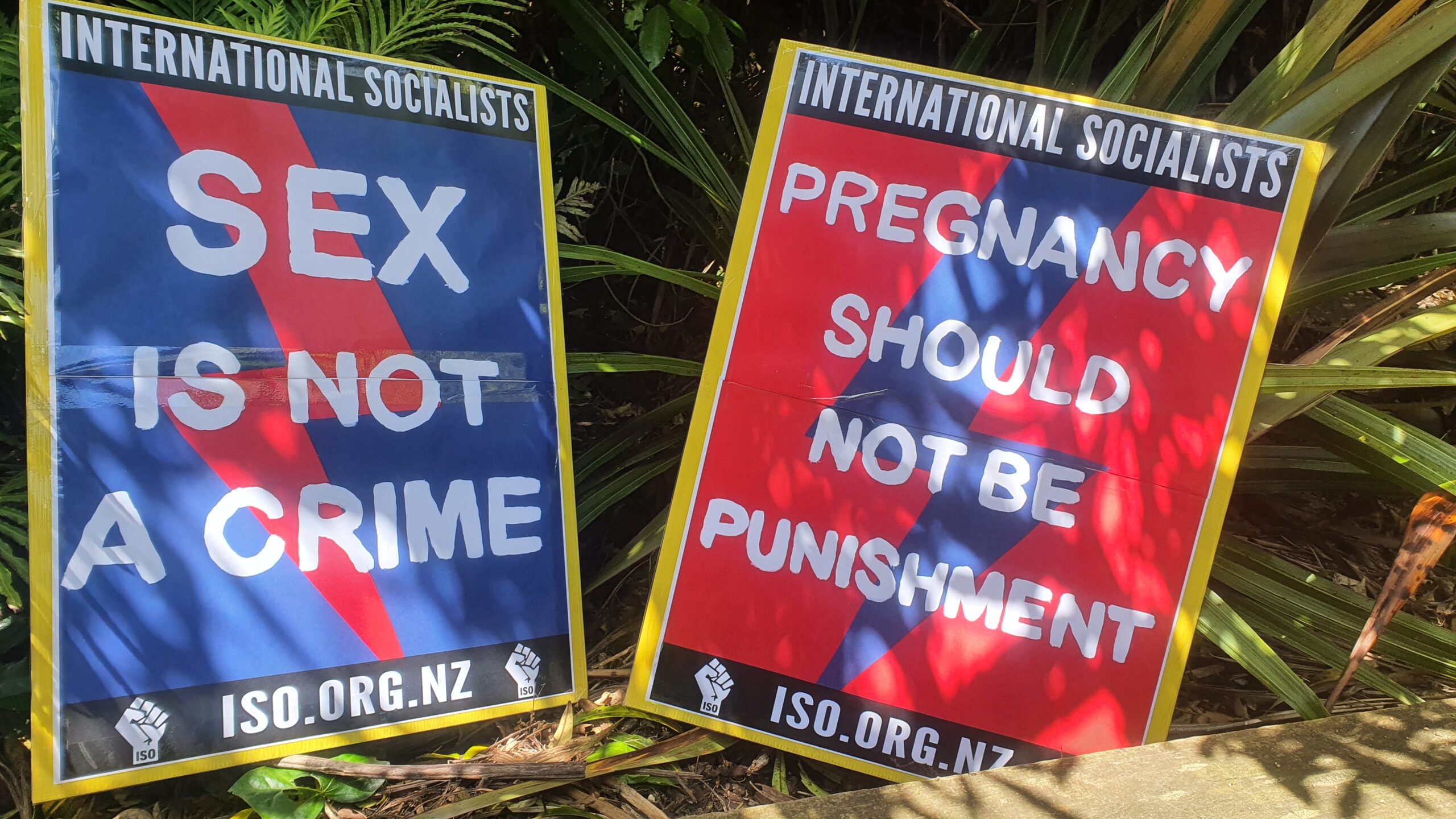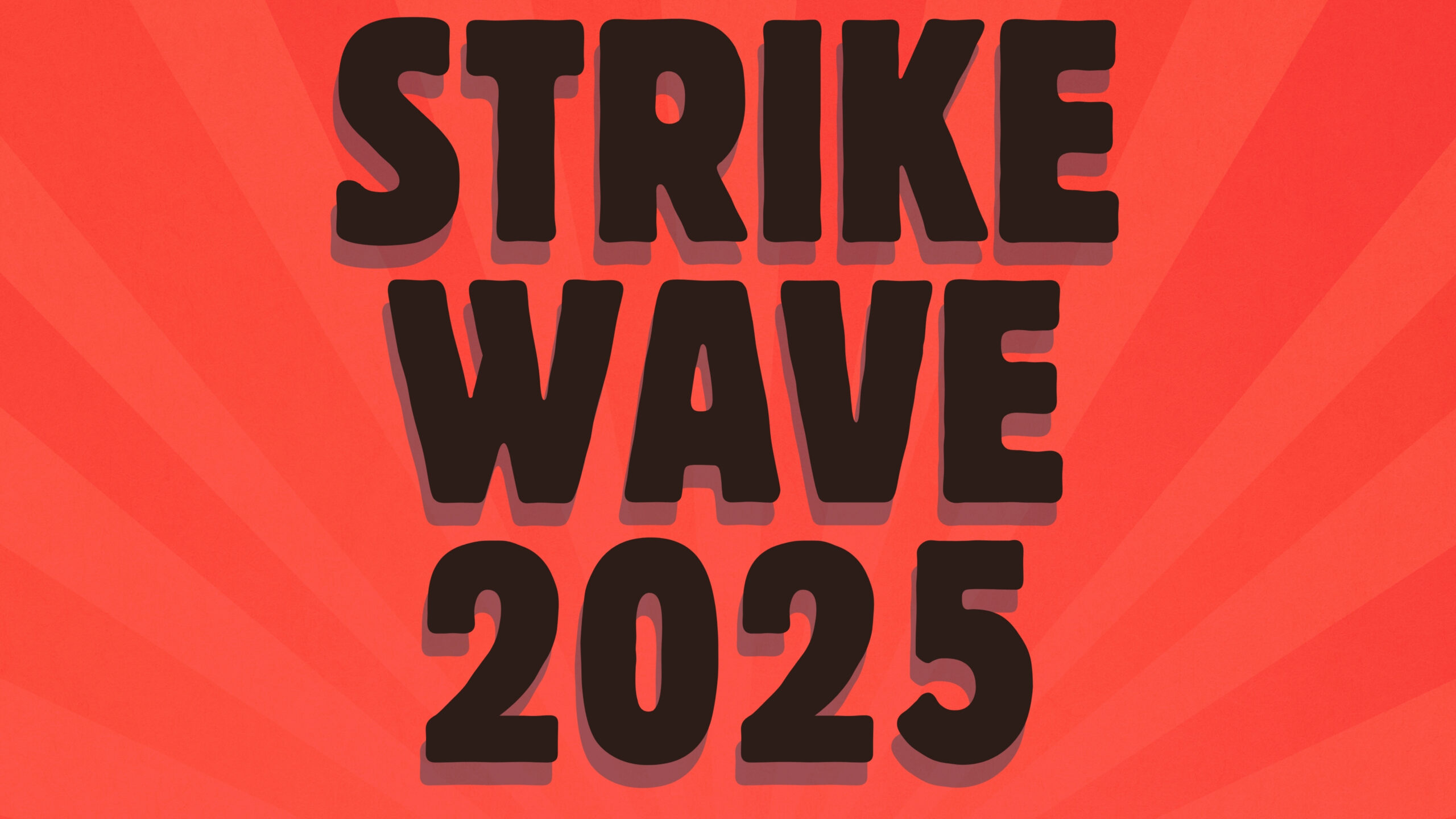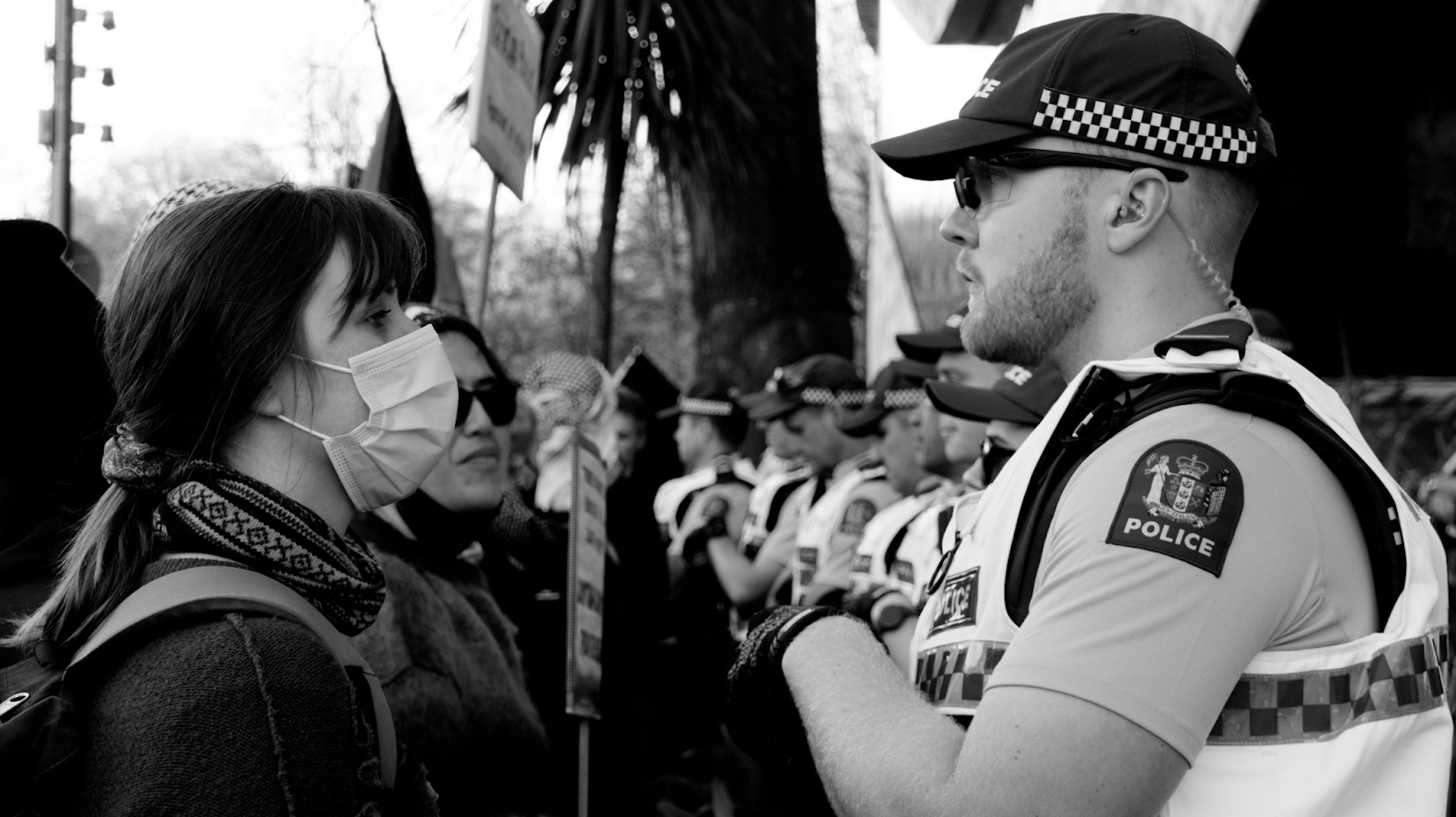Another round of Crown confiscations stand before us. Among the current onslaught of law-changes, the Government has recently announced its plans to overturn the 2023 Court of Appeal decision which lowered the threshold for meeting Customary marine title claims. The history here gets tangled easily, so let’s break it down in chronological order (an oversimplification, but a necessary one):
- Leading up to 2003, the Crown was under the assumption that it had full ownership over the foreshore and seabed—this is the land below the high tide mark and 12 nautical miles (22 km) out to sea. Or, as Māori rights activist Malcolm Mulholland put it, where Tangaroa meets Papatūānuku.
- That year, however, the Court of Appeal found that no one, in fact, owned this land. This allowed the possibility for Māori to claim customary marine rights, which recognise and protect historic practices such as gathering seaweed, planting native species, launching waka, or imposing rāhui.
- The Clark Government immediately responded by declaring that ‘steps will be taken to confirm absolute Crown title over the foreshore.’ By November 2004 it had passed the Foreshore and Seabed Act, which initiated Crown ownership of the land. In effect, this law extinguished customary title, curtailed rights to due process, and constituted the legislative theft of Aotearoa’s coast.
- In reply to the Government’s actions—around this law, but also collecting outrage over its abandoned commitment to ‘close the gaps’ between Māori and Pākehā—a massive hīkoi on Parliament was organised. Helen Clark, who had done her best to ignore and rebuff the dissent, was caught by television cameras peeking out her office window as over 20,000 protestors completely filled the Beehive grounds and surrounding streets. It remains the largest demonstration in Aotearoa’s public memory.
- In 2011 the Foreshore and Seabed Act was replaced by the Marine and Coastal Area (Takutai Moana) Act. The new legislation returned the “no ownership” assumption to the area, and restored the right of Māori to claim customary title—so long as they have ‘exclusively used and occupied the area from 1840 to the present day without substantial interruption’, proof provided.
- That condition, however, would prove extremely difficult to meet. At the time of the Act’s passing Hone Harawira called it a ‘fraud’, given ‘the research showing that 98 per cent of Māori will not be able to prove unbroken tenure.’ To this day only a handful of iwi have successfully done so.
- To remedy this, the Court of Appeal in 2023 significantly lowered the threshold for Māori to claim customary marine title, fulfilling the previous aspirations for the Takutai Moana Act. It is this decision that the government wants overturned. Treaty of Waitangi Negotiations Minister Paul Goldsmith denies this would ‘open up the Foreshore and Seabed debate of 2004.’ But in essence, that is exactly what is happening.
As proof, the issue received a burst of public attention in August when the New Zealand Herald published a full front-page advert by Hobson’s Pledge. The ad, which intended to promote their ‘Save Our Shores’ campaign, read: ‘Restore the Foreshore and Seabed to Public Ownership’, and included scaremongering claims about Māori stealing land. In response Kawea Te Rongo, the Māori Journalists Association, alongside 170 legal experts, strongly condemned the Herald for agreeing to publish the ad. Waatea News and Te Pāti Māori announced a boycott.
Foreshore and seabed legislation has been central to the trajectory of Māori parliamentary politics in the 21st Century. The Māori Party—as it was known then—was formed in 2005 after Tariana Turia left Labour in rejection of the bill. But since then its repeal was a central plank in the party’s confidence and supply agreement with National in 2008, and a point of departure for Hone Harawira who went on to form the Mana Party in the next election. Given little has happened to diminish the importance of this legislation, it may provide an instructive lens for anticipating what comes next.
Current criticism over the future of the Bill tends to focus its aim squarely at Ministers Paul Goldsmith and Shane Jones, who have been heading this change. Undoubtedly, they deserve all the scorn that comes to them. At the same time, however, this view is all too narrow. Goldsmith and Jones—even the NACT coalition more broadly—are at the tail end of this history, not the origin. Understanding this development requires a more precise investigation.
Access debate
Let’s be absolutely clear: granting Marine Customary Title to Māori does not, and cannot, restrict public ownership of that land. The legal recognition here is a continuation of practice, not privatisation.
But we need not get twisted up in legal definitions when we can simply look at the evidence. Since the Act was repealed in 2011, not a single accusation of ‘land-stealing’ has come to pass. No beaches have been removed from public access by Māori, no coastal areas have been sold. On the contrary, it is the Crown who has withdrawn a bulk of our State Assets prior to, and after, 2004 in a sweep of privatisations by the Lange and Key Governments. And due to corner-cutting and poor regulation, those corporations restrict public access far beyond their borders. Even waterways that remain open have been glutted with industrial effluents, acidic runoff, forestry slash, and shit.
Far from blocking access, Māori have been instrumental in the struggle against land seizures. In 2002 alone Ngapuhi prison opponents blockaded a site near Kaikohe to stop the construction of a $100 million prison, and Ngāi Tāmanuhiri activists saved public access to Te Kuri o Pāoa in a powerful land occupation. The Crown has no such concerns: prior to the 2004 Foreshore and Seabed Act it was in fact planning a coastal tendering regime for marine farming. At the time it was widely expected that this measure would have led to the privatisation of large areas of coastal space within the Marlborough Sounds—the very area it accused Māori of impeding.
What’s clear here is that “public” ownership in the Crown’s hands threatens, rather than ensures, accessibility. Under Mmarine Ttitle, land is considered ‘inalienable,’ and thus cannot legally be sold or privatised. The battle here is between forms of recognition: ‘full’, ‘absolute’ ownership of the land, and a Title that protects ongoing material, cultural, and spiritual ties. Any conflict over a particular law, Marxist writer Raymond Williams suggests, reflects the kinds of social world we want to live in. Two very different worlds emerge here, then: one in which our relationship to the Earth is mediated by the totalitarian intent of capital, being consolidated here; and another by a metabolic logic of kaitiakitanga, threatened to be lost.
The role of industry
But arguing that the Crown is deceptive is a fairly obvious point. Perhaps a more useful thing is to ask: who does it serve? Let’s follow the money.
Two months before the Government’s announcements, leading Seafood Industry Representatives contacted Ministers Goldsmith and Jones to complain about Customary Marine Title claims causing legal challenges to their commercial fishing operations. In a secret meeting shortly after, Goldsmith fully backed their claims, stating a ‘solution is imminent’ that ‘should reduce the 100% of coastline subject to CMT to 5%’. Jones agreed that ‘we need to change the law re wāhi tapu areas’, and added that he ‘was trying to have the RMA removed from fisheries’.
Foreshore and Seabed legislation has long been a thorn in the side of the Fishing industry. Throughout the 1990s marine farming in Aotearoa grew from a reasonably small industry to a booming sector as companies noticed its coastal waters were ideal for rapid seafood production. This burst of activity, however, quickly ran into problems. Demand for water space increased by 400% during this time, and by the 2000s it was starting to run out. Frustrated with the red tape around these areas, marine farmers pressured the government to strip away restrictions on their activity. This was made even more urgent, Moana Jackson and Tu Wylie noted, as new developments in technology had opened the possibility for deep-sea farming. The prospect of ‘billions of dollars in rents from ocean ranches’, they argued, was ‘the main motivation for the crown to keep ownership of the sea-bed’.
Following the thread of these ranches—or ‘open ocean farms’—through to today leads us to some telling evidence. Offshore farming, it turns out, has been heralded as ‘the next frontier’ for fisheries in the past few years, and the New Zealand industry is currently trying to secure space for their own operations. Sanford Limited, for instance, has plans for a marine farm at the south-east end of Foveaux Strait—an area where several applications have been made for Customary Marine Title.
Anyone still uncertain about racism’s function here need only read the public submissions made to Ngāti Koata’s—separate—title application, where the vile, Brashian language of ‘greedy’ and ‘selfish’ Māori articulates the polite ‘concerns’ and ‘apprehensions’ of Sanford Limited, Southern Inshore Fisheries Managing Co., The Marine Farming Association, The Canterbury/Marlborough Rock Lobster Stakeholder Group, and a further series of business owners. Strangely enough, none of these complaints reserved judgement for commercial ports, aquaculture holdings, or any other privatised land whose authority over public access is total and enforced by law.
Conclusion
If these accusations feel displaced, it is surely because they indicate considerable anxiety in parts of the ruling class. No one pays for a full front-page advert in the Herald—no cheap effort—if they aren’t worried about their position.
In recent years Māori protest has been a main channel through which dissent and resistance to capital has been activated. The occupations of Ihumātao and Marukaikuru (Shelly Bay) not only created a massive headache for property developers, but helped rouse a dormant protest movement knocked back by the fifth National government. The massive budget day hīkoi called by Te Pāti Māori earlier this year—at 10,000 people, the largest parliamentary protest since 2004—made the political strike suddenly thinkable again. And this at short notice, with widespread uncertainty about the legal implications. Imagine what a nationally coordinated movement with advance notice might bring about.
Such plans are already being dreamt up. In response to the proposed raupatu, Te Pāti Māori have told the government to get ready for similar protest to 2004, promising ‘fireworks ahead’. Last August a coalition of longtime Māori activists—Hone Harawira, Annette Sykes, Mereana Pittman, Ken Mair and Tame Iti—organised a national call to action against the current blitzkrieg of attacks. Organising networks are starting to take shape. Thanks to the strong foundation of recent Palestine activism, a seasoned layer of organisers, speakers, marshals, and marchers are now in place, ready to collect and and uphold a possible Hīkoi round two.
Photo credit: Protest against foreshore and seabed confiscation, 2004.









